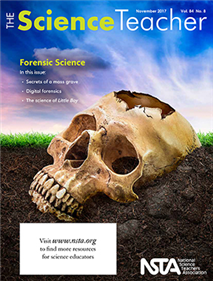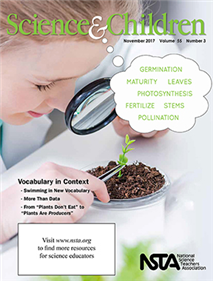All Resources
Journal Article
Using the techniques of forensic anthropology to gather and analyze evidence....
Journal Article
Using smartphones to explore metadata in a simulated criminal case....
Journal Article
Investigating the chemistry behind the first use of a nuclear weapon in warfare....
Journal Article
Students take turns playing different roles to learn the essential skill of collaboration....
Journal Article
Editor's Corner: Forensics: Solving Mysteries With Science
The Science Teacher’s editor shares thoughts on the current issue....
Journal Article
Science 2.0: Use 3D Printers to Teach Design Thinking
This column shares web tools that support learning. This month’s issue covers how a 3D printer is a helpful tool to use when teaching students design thinking, a process for identifying and proposing solutions to real-world problems....
Journal Article
The Green Room: Species That Benefit From Climate Change
This column focuses on making your teaching more environmentally friendly. This month’s issue explores invasive plant species and their relation to climate change....
Journal Article
Focus on Physics: Elementary Electricity in a Nutshell
This column helps teachers build an understanding of physical principles. This month covers the basics of electricity....
Journal Article
Idea Bank: Document a Crime Scene With Smartphone Apps
The Idea Bank provides tips and techniques for creative teaching, in about 1,000 words. This month’s Idea Bank discusses how in a forensic science course, students apply their critical-thinking skills and knowledge of math and science to solve sim...
Journal Article
Career of the Month: Forensic Entomologist
This column shares interviews with professionals using science in the workplace. This month’s issue describes Michelle Sanford's career path to becoming a forensic entomologist....
Journal Article
Right to the Source: The History of Fingerprinting
Exploring science and history with the Library of Congress. This month's issue discusses the history of fingerprinting using a poster for a neighborhood fingerprint station used during World War II....
Journal Article
Exploring interesting animals leads to gains in vocabulary—with an assist from technology for assessment....
Journal Article
Using interactive science notebooks to engage students in science and engineering...
Journal Article
From “Plants Don’t Eat” to “Plants Are Producers”
The role of vocabulary in scientific sense-making...
Journal Article
A Cucurbit Ripe for Building Vocabulary
A garden-based project offers multiple opportunities for addressing standards....
Journal Article
Using a multi-literacy approach to teach about adaptation...
Journal Article
Editor's Note: Making Sense of Science Terms
Science and Children’s editor shares thoughts regarding the current issue....
Journal Article
Teaching Through Trade Books: Inventions Take Center Stage
Exploring interesting animals leads to gains in vocabulary—with an assist from technology for assessment....
Journal Article
The Poetry of Science: Words, Words, Words
Building literacy in playful, meaningful ways. This issue discusses synonyms....
Journal Article
Formative Assessment Probes: Vocabulary in Context: What Is an Amphibian?
This column focuses on promoting learning through assessment. This month’s issue explores what characteristics make an amphibian....
Journal Article
Science 101: Why Aren’t There Magnetic Charges?
This column provides background science information for elementary teachers. This month’s issue discusses electricity and magnetism....




